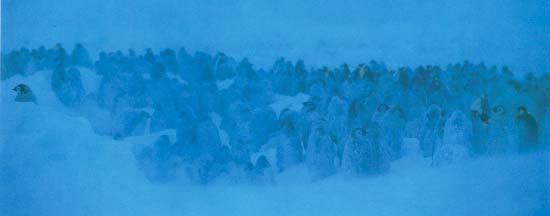 |
 |
Birds have high basal metabolic rates & so use energy at
high rates. Among birds, songbirds (passerines) tend to have higher basal
metabolic rates than nonpasserines. And, of course, the smallest birds,
hummingbirds, have the highest basal metabolic rates of all birds. In general,
basal metabolic rate (or BMR) is related to mass, with larger birds expending
less energy per unit weight than smaller birds.
|
|
|
|
|
|
|
|
| Trumpeter Swan |
|
|
| Brown Pelican |
|
|
| Common Raven |
|
|
| American Kestrel |
|
|
| White-crowned Sparrow |
|
|
| House Wren |
|
|
| Rufous Hummingbird |
|
|
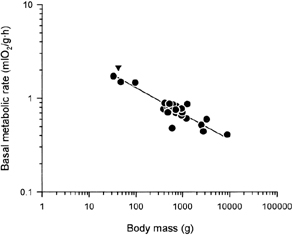
Double logarithmic relationships between BMR and body
mass for 21 avian herbivores
from the literature (black circles) together with data
obtained for the
Rufous-tailed
Plantcutter
(Phytotoma rara; black triangle). The line represents the regression obtained
with these
values, with the equation: BMR = 4.95 mb-0.286
(Rezende et al. 2001).

Log10 mass-specific basal rate of metabolism
as a function of log10 body mass in a barbet, toucans, a hornbill,
fruit pigeons (including Ducula pacifica), and
flying foxes (pteropodids;
Dobsonia moluccensis
& Pteropus vampyrus). Also shown are the standard
curves for nonpasserines (Aschoff and Pohl 1970 ),
all birds (Reynolds and Lee 1996 ), and all mammals (Figure
from: McNab
2001).
As with metabolic rates, birds tend to have higher body temperatures than mammals. In general, body temperatures of birds range from about 38 - 42 degrees C. Body temperatures of large flightless birds (e.g., ostrich & emu) and some aquatic birds (e.g., penguins) are on the lower end of this range (& within the range of mammals).
| Relationship
between metabolic rate & size, food habits, & altitude -- McNab (2003) reported that 99% of the variation in metabolic rate among
different species of birds
of paradise (N = 13) was based on three factors: body weight, food
habits and the altitude at which the birds live. New Guinea is home to
most birds of paradise. The birds get their name from the unique circumstances
surrounding their discovery by Europeans in the 1500s. When the first preserved
specimens reached Spain, their feet had been removed. The oddity of these
seemingly footless birds, combined with their unique colors and shapes,
prompted the Spanish to conclude they spent their whole lives aloft - in
the metaphorical paradise of the sky - without ever alighting on Earth.
McNab's experiments involved placing the birds in sealed chambers, pumping in air and measuring how much oxygen they consumed - to determine their basal metabolic rates. As with all animals, the biggest factor in determining metabolism was body size. The bigger the bird, the more energy it used, with body size alone accounting for 91% of the variation in metabolism between species. Food habits and altitude also influenced metabolism. Species that eat only fruit had lower metabolism than those that ate fruit and insects, and birds living at altitudes below about 3,500 feet had lower metabolisms than those at higher elevations. Together, the three factors accounted for 99% of the variation in metabolic rates among different species, a "really unusual" result, McNab said. McNab said it isn't clear why it takes less energy to keep fruit-eating, lower altitude-living birds of paradise alive. One possible explanation, he said, may be that fruits are seasonal so there may be some periods when they are unavailable, and birds that use less energy are better equipped to survive such periods of scarcity. Lower altitudes also tend to be warmer, so lower-altitude birds would not need as much energy to remain warm and active, he said. |

zoologist Brian McNab in an enclosure at the Papua New Guinea University of Technology. |
Birds of Paradise
Basal metabolic rate of birds is associated with temperature and precipitation, not primary productivity (White et al. 2007) -- Basal metabolic rate (BMR) represents a significant component of animal energy budgets, and is correlated with a range of ecological, physiological and life-history variables, as well as phylogeny. However, even after accounting for the effects of body mass, considerable interspecific variation remains, and understanding the causes and consequences of this variation is key to understanding how animals function in the wild and the limits that are set on their physiological performance. A classic adaptive explanation for variation in BMR derives from the observation that species from hot arid environments have lower BMRs than species from non-arid environments. This is postulated to result from the need to reduce (i) the rates of endogenous heat production in hot environments where evaporative water loss is restricted by water scarcity, and (ii) the food requirements and energy expenditure in environments where resources are sparse and widely distributed. Complementary to this, the high BMRs of species from temperate and polar latitudes are associated with high maximal rates of thermogenesis and increased cold tolerance.
A link between low environmental productivity and animal metabolism in arid environments is intuitively appealing. However, a simple dichotomous distinction between hot- and non-arid environments conceals a suite of biotic and abiotic characteristics, any or all of which could account for the observation of lower BMRs with increasing aridity. Characteristics of hot arid environments include low primary productivity, low and temporally unpredictable precipitation, extreme ambient temperatures and high potential evapotranspiration, each of which has been shown to be related to BMR. For example, among birds, BMRs of falconiform species from hot climates are lower than those from colder climates, and the BMR of larks (Alaudidae) is negatively correlated with a continuous measure of aridity that incorporates ambient temperature and precipitation. Among mammals, BMR is positively correlated with net primary productivity (NPP) and rainfall, and negatively correlated with ambient temperature and rainfall variability.
The BMRs of birds from the wet tropics are also thought to be lower than those of temperate species, but since wet tropical (luxuriant) environments are characterized by both high temperatures and high environmental productivities, a specific causal relationship between BMR, temperature and productivity has not been established. Previous studies have favoured single cause analyses, such as the classic arid-mesic dichotomy, and therefore failed to separate these variables as predictors. Other studies failed to include habitat productivity as a potential predictor of BMR, or they considered only a limited range of ambient temperature or environmental productivity. It is therefore unclear which component of the 'arid-luxuriant' dimension (precipitation, ambient temperature, productivity or some combination) best accounts for broad-scale variation in metabolic rate. White et al. (2006) collated BMR measurements for 92 populations representing 90 wild-caught species and examined the relationships between BMR and NPP (annual net primary productivity), Ta (extreme ambient temperatures), annual temperature range (Tr), and precipitation and intra-annual coefficient of variation of precipitation (PCV). Their analysis of the relationship between avian BMR and environmental variables revealed that BMR was negatively associated with Ta and Tr, and positively associated with PCV. Thus, the relatively low BMR of birds inhabiting hot arid environments arises as a consequence of generally high temperatures with seasonal extremes. In hot environments, low BMR presumably reduces endogenous heat load, and the low BMR of birds inhabiting luxuriant environments also arises as a consequence of the associated high temperatures.
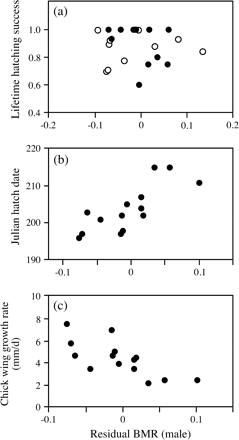 |
In male Leach's Storm-Petrels, the relationship between residual BMR and (a) the lifetime hatching success of males whose BMRs were measured in 2000 (open circles) or 2001 (filled circles) (p = .65), untransformed lifetime hatching success data are presented to facilitate interpretation; (b) Julian hatching date in 2001 (P = 0.001); and (c) chick wing growth rate in 2001 (P = 0.003). Residual BMR was calculated using a GLM incorporating body mass, year, breeding age, sex, Julian date on which BMR was measured, and time of day when measured. |
Basal metabolic rate and reproductive performance in storm-petrels -- Despite evidence that some individuals achieve both superior reproductive performance and high survivorship, the factors underlying variation in individual quality are not well understood. The compensation and increased-intake hypotheses predict that basal metabolic rate (BMR) influences reproductive performance; if so, variation in BMR may be related to differences in individual quality. Blackmer et al. (2005) evaluated whether BMR measured during the incubation period provides a proximate explanation for variation in individual quality by measuring the BMRs and reproductive performance of Leach's Storm-Petrels (Oceanodroma leucorhoa) breeding on Kent Island, New Brunswick, Canada, during 2000 and 2001. They statistically controlled for internal (body mass, breeding age, sex) and external (year, date, time of day) effects on BMR, and found that males with relatively low BMRs hatched their eggs earlier in the season and that their chicks' wing growth rates were faster compared to males with relatively high BMRs. Conversely, BMR was not related to egg volume, hatching date, or chick growth rate for females or to lifetime (23 years) hatching success for either sex. Thus, for males but not for females, our results support the compensation hypothesis. This hypothesis predicts that animals with low BMRs will achieve better reproductive performance than animals with high BMRs because they have lower self-maintenance costs and therefore can apportion more energy to reproduction. These results provide evidence that intraspecific variation in reproductive performance is related to BMR and suggest that BMR may influence individual quality in males.
Thermoregulation
To maintain body temperature, the physiological & metabolic reactions that produce heat must be balanced against those that radiate or conduct it away. Except within a range of ambient temperatures called the thermoneutral zone, maintaining a constant body temperature makes a steady demand either on the biochemical processes of heat production and/or the physical mechanisms for heat loss.
When ambient temperatures fall below the thermoneutral zone (lower critical temperature or LCT), heat production must increase and/or heat loss must decrease. Above the other end of the thermoneutral zone (upper critical temperature or UCT), heat loss must increase.

Thermoneutral zones and basal metabolic rates may vary with season (e.g., West 1972):
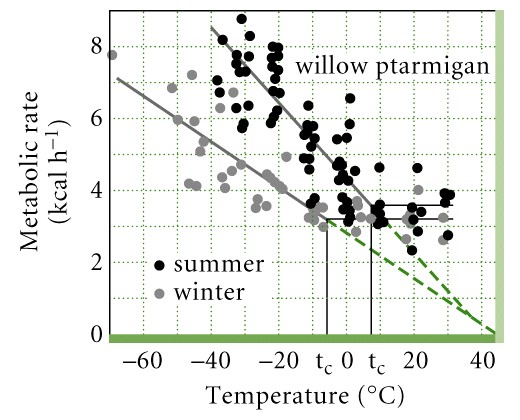
During the winter, Willow Ptarmigans produce a denser
coat of feathers and actually lower
basal metabolic rates, which reduces
the gradient between the internal body temperature and
the external temperature. This is the same as keeping your house at a cooler
temperature to
reduce your heating bill. Both responses reduce the amount of energy necessary
to stay warm.
(Source: Ricklefs 1993, p. 189, Fig. 10.11; http://ecology.botany.ufl.edu/ecologyf02/homeostasis.html)
Birds in a Changing Climate
Climate change is rapidly becoming the major threat to biodiversity globally, and birds are no exception. For the past ten years, the Hot Birds Research Project team, led by Dr Susie Cunningham at the FitzPatrick Institute of African Ornithology at the University of Cape Town, and her collaborator Prof Andrew McKechnie at the University of Pretoria, have been working to find out how climate warming will affect the birds of hot deserts globally. They have learned much about the thermal physiology of birds, how they cope with rising temperatures, and the limits of their tolerance. They have also discovered species that are uniquely vulnerable and why, that the behaviour of birds can be as important as their physiology in shaping how they cope (or don’t cope) with high temperatures, and that behavioral changes for keeping cool carry costs that could reverberate through ecosystems.
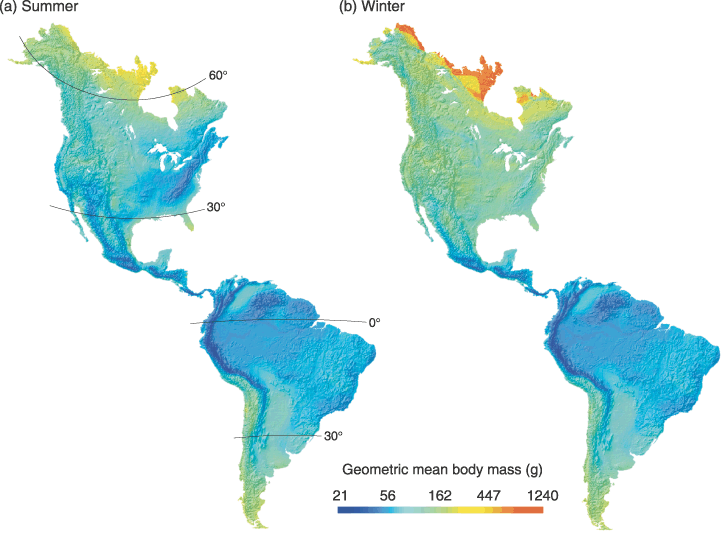
Birds are larger in the temperate zones than in the tropics. The gradient is quantitatively stronger in winter than in summer. In summer, phylogenetic and adaptive responses of birds contribute equally to the gradient. In winter, the gradient in North America is much stronger than that expected by taxonomic turnover, and responses of species independent of their family membership drive the overall pattern. The results of this analysis by Ramirez et al. (2007) confirmed Bergmann's rule in New World birds and indicate that winter temperatures ultimately drive the pattern, exerting selection pressures on birds to become larger (i.e., with relatively less surface area). However, in summer, the movement of migratory species into the temperate zone weakens the gradient and generates a pattern more congruent with that expected from the taxonomic composition of the fauna.

Prediction of how the energy and water requirements of endotherms should change with environmental temperature and body size (small, medium or large). For any given size, metabolic rate (in blue) declines as temperature increases until the basal metabolic rate is reached. Above a threshold temperature, water-loss rate (in orange) increases. The range of ambient temperatures in between, where energy and water requirements are at basal levels, is known as the TNZ (thermoneutral zone). As body size increases (thicker lines), the TNZ becomes broader and shifts to cooler environments; thus the long-term energy and water requirements of larger individuals are minimized in cooler environments. Although the upper boundary of the TNZ of larger individuals occurs at lower ambient temperatures, smaller individuals lose water proportionally faster above this threshold and, hence, dehydrate faster under extreme heat (From: Gardner et al. 2011).
Energy transfer between birds and their environment is influenced not just by changes in ambient temperature, but also by changes in factors like wind velocity.
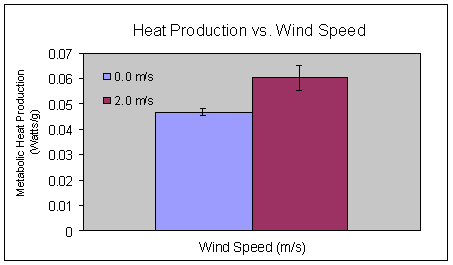
Metabolic heat production of a House Sparrow exposed
to no wind
and a wind speed of 2 meters/second.
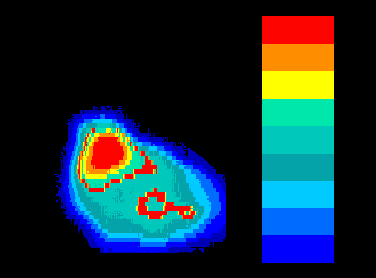 |
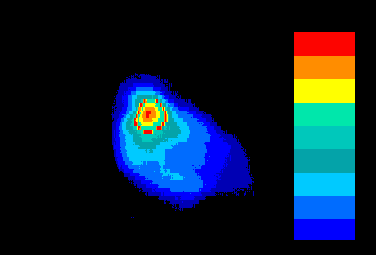 |
Heat production:
| Different shivering threshold temperatures in different muscles -- Carey et al. (1989) observed that the thermal thresholds for the onset of shivering in the leg muscles of winter acclimatized adult House Finches (Carpodacus mexicanus) were substantially below the thresholds for the onset of shivering in the pectoralis muscle. Shivering began in the pectoralis at an ambient temperature of 20°C, while in the gastrocnemius, tibialis and peroneus muscles the corresponding temperatures were -5, -11, and -14°C, respectively.. | 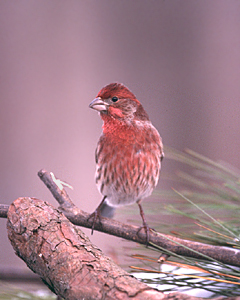 |
Heat loss:
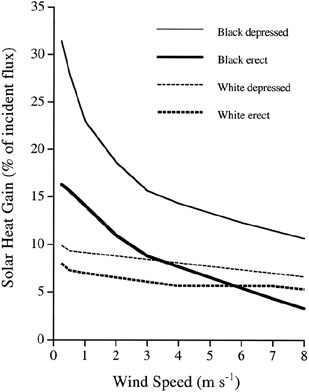 |
|


Examples of urohidrosis in different stork species: (a) Woolly-necked Ciconia episcopus, (b) Painted Mycteria leucocephala and
(c) Marabou Leptoptilos crumenifer storks. In the first two, the whitish residue produced by urohidrosis partiallycovers the legs with feet
showing its natural darker color. With the Marabou Stork, excreta covers completely the legs and feet (Figure from Cabello-Vergel et al. 2021).
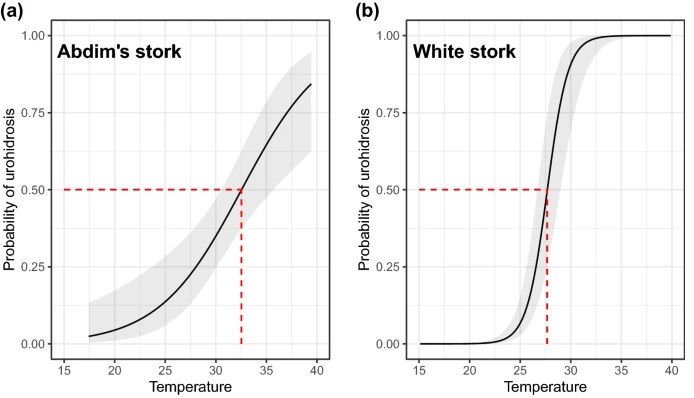
Probability of urohidrosis use in response to air temperature for (a) Abdim’s Storks Ciconia abdimii and
(b) White Storks Ciconia ciconia. Dashed red lines indicate the air temperature at which urohidrosis occurred in
50% of instances (Figure from Cabello-Vergel et al. 2021). .
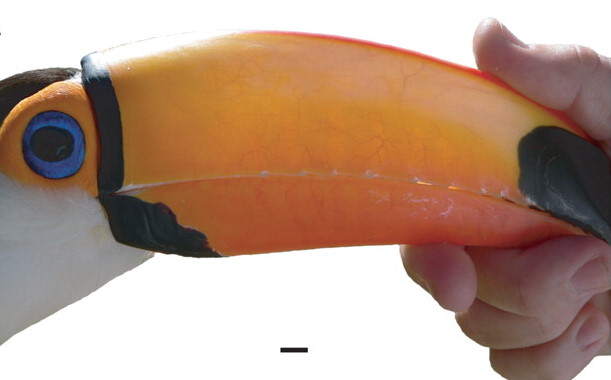
Side view of a Toco Toucan's bill showing visible blood vessels. Scale bar, 1 cm.
Heat exchange from the toucan bill -- Toco Toucans (Ramphastos toco), the largest member of the toucan family, have the largest beak relative to body size of all birds. This exaggerated feature has received various interpretations, from serving as a sexual ornament to being a refined adaptation for feeding. However, it is also a significant surface area for heat exchange. Tattersall et al. (2009) found a remarkable capacity for Toco Toucans to regulate heat distribution by modifying blood flow, using the bill as a transient thermal radiator. Heat loss from the bill is highly variable, and, depending on air speed and ambient temperature, could account for as little as 25% (minimum) to as much as 400% (maximum) of resting heat production in adult toucans, the largest reported for an animal. This capacity for heat loss might become a liability at low temperatures. However, toucans and toucanets are well known for tucking their bills beneath their wings and orienting their tail feathers rostrally during sleep; this posture increases insulation of the bill and mitigates heat loss incurred during sleep.Thus, the toucan's bill is, relative to its size, one of the largest thermal windows in the animal kingdom, rivaling elephants’ ears in its ability to radiate body heat. These results demonstrate that the constraints of heat exchange and the bill’s potential use as a thermoregulatory organ should be considered in understanding the distribution, ecology, and behavior of toucans. Furthermore, given the rapid radiation of bill structures and diversity of beak morphologies of birds, thermal constraints from bill heat loss may prove to be a common feature among many birds.
Toucans can use their bill to keep cool.
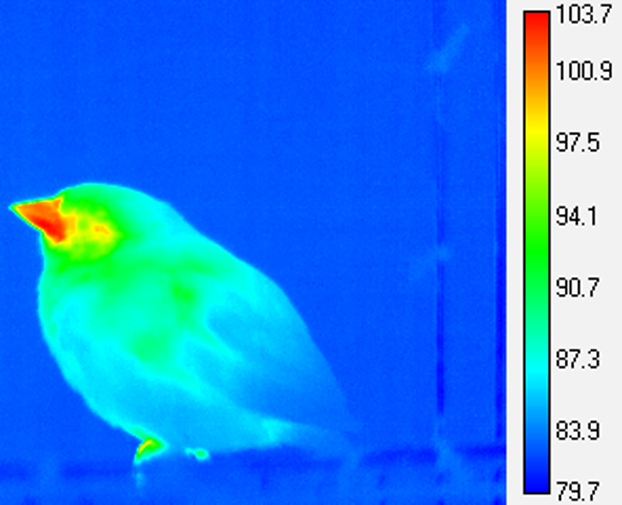
Thermographic image of salt marsh sparrow showing heat radiating from bill (Photo: R. Greenberg)
High summer temperatures and bill size of salt marsh sparrows -- Physiological factors are rarely proposed to account for variation in the morphology of feeding structures. Recently, bird bills have been demonstrated to be important convective and radiant heat sinks. Larger bills have greater surface area than smaller bills and could serve as more effective thermoregulatory organs under hot conditions. The heat radiating function of bills should be more important in open habitats with little shade and stronger convective winds. Furthermore, as a means of dumping heat without increasing water loss through evaporation, bills might play a particularly important thermoregulatory role in heat loss in windy habitat where fresh water is limited. North American salt marshes provide a latitudinal gradient of relatively homogeneous habitat that is windy, open, and fresh-water limited. To examine the potential role of thermoregulation in determining bill size variation among ten species or subspecies of tidal marsh sparrows, Greenberg et al. (2012) plotted bill size against maximum summer and minimum winter temperatures. Bill surface areas increases with summer temperature, which explained 82–89% of the variance (depending upon sex) when controlling for genus membership. Latitude alone predicted bill surface area much more poorly than summer temperature, and winter temperatures explained < 10% of the variance in winter bill size. Tidal marsh sparrow bill morphology may, to a large degree, reflect the role of the bill in expelling excess body heat in these unbuffered, fresh-water-limited environments. This new example of Allen's rule reaffirms the importance of physiological constraints on the evolution of vertebrate morphologies, even in bird bills, which have conventionally been considered as products of adaptation to foraging niche.
Shape-shifting birds: how birds are evolving in response to cimate change by Matthew Symonds
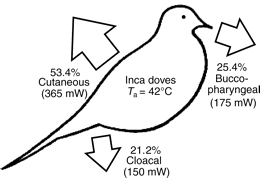
Average apportionment of total evaporation in Inca Doves at 42°C.
Values in parentheses indicate average rates of evaporative heat loss.
Cloacal evaporation and thermoregulation -- Hoffman et al. (2007) presented the first experimental evidence that a bird is capable of evaporating enough water from the cloaca to be important for thermoregulation. They measured rates of evaporation occurring from the mouth, the skin, and the cloaca of Inca Doves (Columbina inca) and Eurasian Quail ( Coturnix coturnix). Inca Doves showed no significant increase in cutaneous evaporation in response to curtailment of buccopharyngeal evaporation. Cloacal evaporation in doves was negligible at ambient temperatures of 30°, 35° and 40°C. However, at 42°C, the apportionment of total evaporation in doves was 53.4% cutaneous, 25.4% buccopharyngeal and 21.2% cloacal, with cloacal evaporation shedding, on average, 150 mW of heat. In contrast, the evaporative apportionment in quail at 32°C (the highest ambient temperature tolerated by this species) was 58.2% cutaneous, 35.4% buccopharyngeal, and 6.4% cloacal. These results suggest that, for some birds, cloacal evaporation can be controlled and could serve as an important emergency tactic for thermoregulation at high ambient temperatures.
| Birds living in cold environments must conserve body heat to avoid hypothermia. However, blood flowing from the body core to the periphery (like the legs & feet) carries heat can be readily lost through the skin. To prevent such loss, birds have a countercurrent heat exchanger - blood vessels in the legs (arteries going in & veins coming out) in close proximity that allow heat to be recaptured and saved. The principle of countercurrent heat exchange is so effective and ingenious that it has also been adapted in human engineering projects to avoid energy waste, e.g., by ensuring good ventilation of buildings while avoiding the loss of heat to the environment on a cold winter's day. |
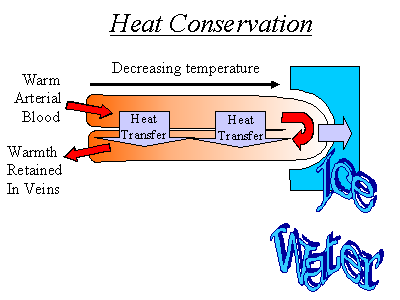
In a countercurrent exchanger, flow in two adjacent tubes (like blood vessels) is in opposite directions. Imagine these are blood vessels in a bird's leg: the artery on top & the vein on the bottom. The artery is bringing warm blood into the legs. As the arrows indicate, heat from the blood in the artery is transferred to the blood in the vein (but, of course, oxygen & nutrients continue on to supply the cells in the feet). As a result of this heat 'exchange', blood in the bird's feet is relatively cool & little heat is lost. So, even a duck standing on ice loses little heat from its feet. |
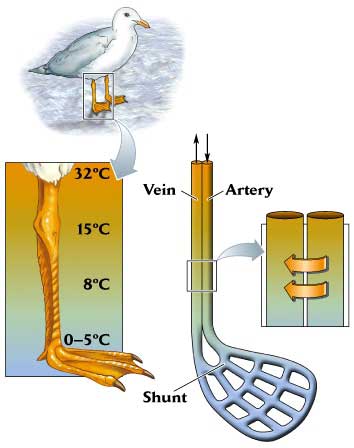
Source: http://ecology.botany.ufl.edu/ecologyf02/homeostasis.html
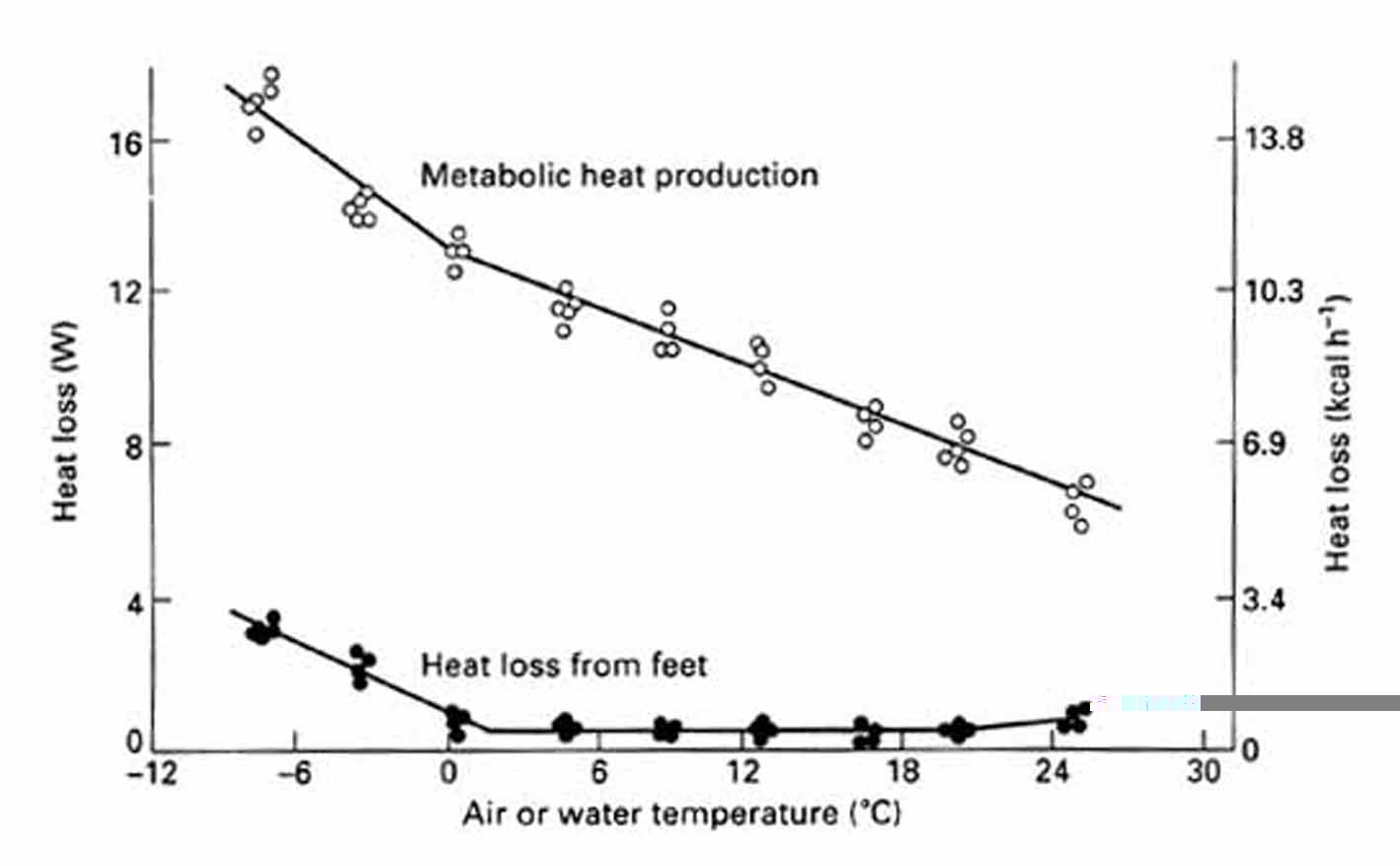
At and below 0 degrees C, intermittent pulses of increased
blood flow to extremities
are used to prevent freezing and tissue damage, reflected
in increased heat loss from the feet
and an increased metabolic rate (Kilgore and Schmidt-Nielsen
1975).
[Source: http://www.sfu.ca/biology/courses/bisc445/lectures/regulation_heat_gain.html]
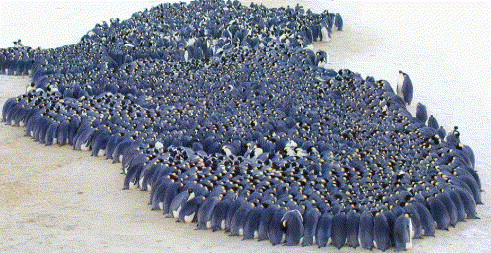
A wintering group of about 2500 Emperor Penguins (From: Gilbert et al. 2006).
Although huddling has been shown to be the key by which Emperor Penguins (Aptenodytes forsteri) save energy and sustain their breeding fast during the Antarctic winter, the intricacies of this social behavior have been poorly studied. Gilbert et al. (2006) recorded abiotic variables with data loggers glued to the feathers of eight individually marked Emperor Penguins to investigate their thermoregulatory behavior and to estimate their “huddling time budget” throughout the breeding season (pairing and incubation period). Contrary to the classic view, huddling episodes were discontinuous and of short and variable duration, lasting 1.6 ± 1.7 (SD) hours on average. Despite heterogeneous huddling groups, birds had equal access to the warmth of the huddles. Throughout the breeding season, males huddled for 38 ± 18% (SD) of their time, which raised the ambient temperature that birds were exposed to above 0 °C (at average external temperatures of − 17 °C). As a consequence of tight huddles, ambient temperatures were above 20 °C during 13 ± 12% (SD) of their huddling time. Ambient temperatures increased up to 37.5 °C, close to birds' body temperature. This complex social behavior therefore enables all breeders to get a regular and equal access to an environment that allows them to save energy and successfully incubate their eggs during the Antarctic winter.
Emperor Penguins
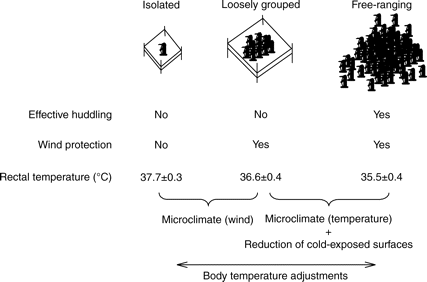
Thermoregulatory status of the three bird categories (isolated, loosely grouped, free-ranging), and associated processes of energetic benefits.
Values are mean rectal temperatures ± SD (Gilbert et al. 2008).
Emperor Penguins (Aptenodytes forsteri) are the only birds that breed in the middle of the Antarctic winter. Males and females fast for 45 days during the pairing period, and males fast another 70 days to assume the incubation task, during which their body temperature has to be constant and high in order to maintain their egg at 35°C. Gilbert et al. (2008) examined the energetic benefits accrued from huddling and estimated the respective contributions of wind protection, exposure to mild ambient temperatures, reduction in cold-exposed body surfaces and body temperature adjustments in these energy savings. The metabolic rate of `loosely grouped' birds (restrained in small groups of 5–10 individuals that are unable to huddle effectively) is reduced by 39% compared to metabolic rate of `isolated' birds, with 32% of these energetic benefits due to wind protection. In addition, metabolic rate of `free-ranging' Emperor Penguins, i.e. able to move freely and to huddle, is on average 21% lower than that of `loosely grouped' birds. Exposure to mild ambient temperatures within the groups and reduction in cold-exposed body surfaces while huddling, though overestimated, would represent a 38% metabolic reduction. About two thirds of metabolic lowering is attributable to the reduction in cold-exposed body surfaces and one third to the mild microclimate created within the groups. Moreover, body temperature adjustments contribute to these energetic benefits: maintaining body temperatures 1°C lower would represent a 7–17% reduction in energy expenditure. These processes, linked together, explain how huddling Emperor Penguins save energy and maintain a constant body temperature, ensuring a successful incubation in the middle of the austral winter.
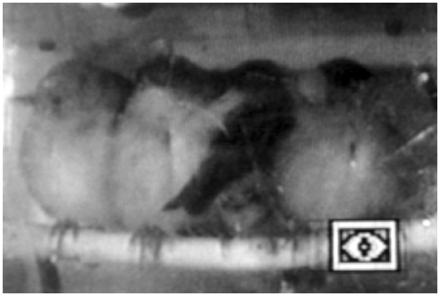
Four Blackcaps huddling in a respiratory chamber.
Huddling by a small migratory songbird -- The success of migration of small passerine birds depends largely on effective refueling at stopover sites. Efficient refueling may not only involve efficient foraging, but minimizing energy use when resting or sleeping. Wojciechowski et al. (2008) observed migrating Blackcaps (Sylvia atricapilla) huddling at a stopover site and suggested that such behavior might reduce their energy expenditure. In a laboratory study, Wojciechowski et al. (2011) found that huddling was beneficial to Blackcaps both from energetic and thermoregulatory points of view. In their experiment, metabolic rates and body temperatures of seven Blackcaps placed in respirometry chambers overnight were measured, either solitarily or in groups of three or four at ambient temperatures of 5, 10, and 15°C. Huddling Blackcaps maintained higher body temperatures than did solitary birds, and also had mass-specific metabolic rates lower by about 30% than those of solitary individuals. These results suggest that huddling may be an important way of saving energy for small passerine birds resting at migratory stopovers. At the same time it might offer the additional benefit of lower risk of predation. These results suggest that huddling may occur frequently in nature, leading to significant savings of energy, faster accumulation of fuel, presumably lower risk of becoming a prey, more successful migration, and eventually increased fitness.
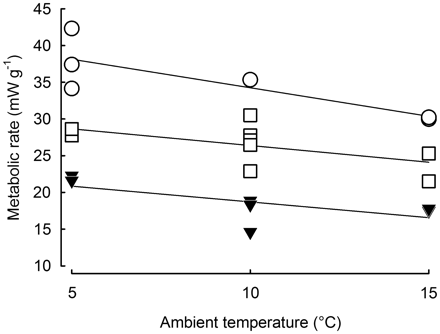
Mass-specific MR of solitary active (open circles), solitary resting (open squares), and huddling (inverted filled triangles) Blackcaps at Ta of 5, 10, and 15°C. Lines are for least-squares linear regression equations fitted to the data for each group. Each symbol represents a datum from a single measurement.
Seminar - Weathering the storm: challenges faced by migrant songbirds in the Arctic by John Wingfield
(seminar begins at about 2:45)
| Stopovers exhaust migrating songbirds - Wikelski et al. (2003) found that migrating thrushes use more energy during stopovers than on the wing. It may seem counterintuitive, but "birds have to prepare for their long flights by accumulating fat and preparing fuel", says Henk Visser, one of the investigators. Finding food during rest breaks and sitting through the cold night (unless birds huddle; see Blackcaps above) can use lots of energy. The discovery may prompt enthusiasts to build bird 'service stations' along migratory routes, says Visser. These reserves might enable similar, but endangered, species to rest, feed and gear up for the next leg of their journey. Every spring, millions of Catharus thrushes migrate from Panama to Canada - a journey of 4,800 km that takes around 40 days. They have regular breaks and fly for just a few hours at night. Over the entire journey, the energy used by a single bird is equivalent to that in half a kilo of worms. Less then 30% of this is used on flight, the team found. The group took blood samples from 6 radio-tagged thrushes before and after a 7-hour migratory night flight to calculate how much energy the birds used. As the birds headed north, the team gave chase in a fleet of cars and a light airplane. "This was the easy part," says Visser. The hard bit was catching them at the other end, he recalls. - Helen R. Pilcher, Nature Science Update | 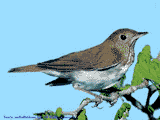
Photo by Dan Sudia |
Avian hypothermia:
| Avian facultative hypothermic responses (McKechnie
and Lovegrove 2002) -- Facultative hypothermic responses have been reported
in species from 29 families (see Figure to the right) representing 11 orders).
However, the capacity for hypothermia in the majority of the 138 avian
families remains unknown. The capacity for moderate hypothermia, during
which body temperature (Tb) is reduced by <20°C, appears widespread.
However, more pronounced hypothermia during which Tb is reduced by 20°C
or more has been reported in only the Trochilidae, Apodidae, and Caprimulgidae
(Fig. 1). The passerine capacity for hypothermia is limited, and Tb reduction
of >10°C has been reported in only 7 of 28 species for which measurements
of minimum body temperature exist. The lowest body temperatures in passerines
were recorded in the Hirundinidae and Nectariniidae.
The capacity for facultative hypothermia shows considerable variation within the Strigiformes. Body temperature reduction of more than 6–8°C has not been observed in owls (Strigidae and Tytonidae). In contrast, reduction in body temperature of more than 10°C appears to be widespread in the Caprimulgidae. The Caprimulgidae also include the only known avian hibernator, the Common Poorwill. The limited data (ca. 1% of extant species) are insufficient to objectively infer general patterns in the phylogenetic distribution of the avian capacity for hypothermia. At best, the available data suggest that the capacity for pronounced hypothermia (i.e., torpor) increases with the relative age of taxa. A pattern of more pronounced hypothermia in phylogenetically older taxa is consistent with current ideas regarding the evolution of heterothermy (daily torpor and hibernation). Some authors have argued that heterothermy may be phylogenetically primitive, although it frequently constitutes a functionally advanced adaptation associated with small body size and unpredictable food supplies. |

Phylogenetic distribution of avian facultative hypothermic responses. The phylogeny is based on Sibley and Ahlquist (1990) . The extent of body temperature reduction (delta Tb) is given as the difference between normothermic rest-phase body temperature (Tnorm) and minimum hypothermic body temperature (Tmin), i.e., delta Tb = Tnorm - Tmin. An asterisk indicates that Tmin was recorded in chicks, not adult birds (From: McKechnie and Lovegrove 2002). |

Change in body temperature (Tb) and O2 consumption (VO2, measured in mL O2 g–1 h–1) with time for an individual Malachite Sunbird at two ambient temperatures. Small dot = VO2; square = Tb |
Nocturnal heterothermy & torpor in the Malachite
Sunbird -- Downs and Brown (2002) examined thermoregulation of Malachite
Sunbirds and found daily fluctuations in body temperature (Tb) & oxygen
consumption (VO2). Surgically implanted minimitters were used to
measure Tb continuously. As ambient temperature decreased, VO2 during
the rest phase did not increase to maintain Tb. No birds remained normothermic
during the night. At 5°C, Malachite Sunbirds became torpid with a decrease
of 15°C in Tb. Birds increased Tb to active-phase levels with the onset
of light. Malachite Sunbirds conserved energy nocturnally by reducing metabolic
rate and Tb. This plasticity in Tb shows that daily variations in Tb of
homeotherms are biologically important. Further, heterothermy (particularly
nocturnal hypothermia and torpor) in small birds would be important in
an unpredictable environment where food resources fluctuate to prevent
an energy deficit.
|
Blackcap
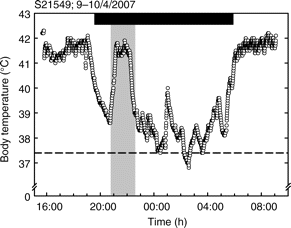
Body temperature of a Blackcap on the night of 9–10 April 2007.
The black horizontal bar at the top of the figure indicates hours of darkness. The vertical gray bar indicates a period with
relatively high nocturnal body temperature, possibly associated with a period of nocturnal migratory restlessness (Zugunruhe). The dashed
horizontal line indicates the lower limit of normal, resting body temperature of 37.4°C
Heterothermy in small, migrating passerine birds -- For small endothermic animals, heterothermy serves as an energy-saving mechanism for survival in challenging environments, but it may also accelerate fat accumulation in individuals preparing for fuel-demanding activities. By monitoring body temperature (Tb) of eight Blackcaps (Sylvia atricapilla) by radiotelemetry, Wojciechowski and Pinshow (2009) found that mean body temperature was 42.5°C during the day, but decreased to a minimum between 33 and 40°C at night. Measurements of metabolic rate in birds subjected to an ambient temperature of 15°C showed that hypothermia of this magnitude can lead to a reduction of some 30% in energy expenditure. These data suggest that by reducing their body temperatures at night to conserve energy, Blackcaps accelerate their rate of fuel accumulation at a stopover site. Because hypothermia may lead to significant energy savings and facilitate a gain in body mass, similar behavior may be common among small migrating passerines.
| Dominant
birds stay leaner than their subordinates -- Legend says that the early
bird gets the worm, but research suggests that the bird that dines just
before going to bed has the real advantage. Pravosudov et al. (1999) found
that socially dominant birds in three species (Carolina Chickadee, Tufted
Titmouse, and White-breasted Nuthatch) are generally leaner than subordinate
peers, probably because they can eat when they want. Dominant birds stay
lean during the day, then pack on the fat just before a chilly winter night.
Staying lean helps birds stay more maneuverable during attacks by predators.
Lean birds also have more time to watch for predators, rather than looking
for food. "Natural selection would like to keep a bird as thin as possible,
but also have enough fat to get through the night," said Thomas Grubb,
a co-author of the study. By eating late, dominant birds can reduce their
risk of predation without increasing their risk of starvation." Subordinate
birds have a less predictable food supply during the day because they must
look for food in places that dominant birds wouldn't normally bother with,"
according to Grubb. Also, dominants can displace subordinates from food.
"It seems that subordinate birds must carry more fat during the day as
an 'insurance policy,' making them more vulnerable to capture by predators,"
he said. A bird can gain as much as 10% of its total body mass each day
in fat. Gaining fat before nightfall can help birds survive in winter because
they often go into hypothermia as a survival mechanism. Birds can lower
their body temperatures by as much as 42 degrees F. During the night, birds
tend to lose their accumulated body fat. "Extra fat at roosting time means
a bird needs to go less far into hypothermia at night because it has more
energy for metabolism," Grubb said. "Hypothermia is thought to be a cost,
because it makes a bird less aware of its surroundings, therefore increasing
its vulnerability to nocturnal predators."
Photos by David Roemer |
|

Source: http://ecology.botany.ufl.edu/ecologyf02/homeostasis.html
Big Birds Can Keep Their Cool Too - Researchers
have found the biggest example yet of a bird that 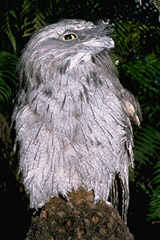 cools
down to conserve energy (Kortner et al. 2001). The Australian Tawny
Frogmouth (Podargus strigoides), which weighs in at half a kilogram,
uses ‘torpor’ — as a controlled reduction of body temperature is properly
called — as a survival strategy in winter, even though it is almost ten
times larger than any other bird known to do so. Fritz Geiser and colleagues
of the University of New England, Armidale, Australia, fitted seven frogmouths
with external temperature-sensitive transmitters and three of those with
internal temperature-sensitive transmitters, and tracked the birds’ temperatures
every 10 minutes for 9 months. During winter, Geiser’s team was surprised
to find, these big birds regularly enter torpor. “This enables the bird
to remain resident in its territory throughout the year.” Avian torpor,
they predict, is much more common than is currently believed. cools
down to conserve energy (Kortner et al. 2001). The Australian Tawny
Frogmouth (Podargus strigoides), which weighs in at half a kilogram,
uses ‘torpor’ — as a controlled reduction of body temperature is properly
called — as a survival strategy in winter, even though it is almost ten
times larger than any other bird known to do so. Fritz Geiser and colleagues
of the University of New England, Armidale, Australia, fitted seven frogmouths
with external temperature-sensitive transmitters and three of those with
internal temperature-sensitive transmitters, and tracked the birds’ temperatures
every 10 minutes for 9 months. During winter, Geiser’s team was surprised
to find, these big birds regularly enter torpor. “This enables the bird
to remain resident in its territory throughout the year.” Avian torpor,
they predict, is much more common than is currently believed. |
Tawny Frogmouths
Literature Cited:
Andreev, A. V. 1991. Winter adaptations in the Willow Ptarmigan. Arctic 44:106-114.
Aschoff, J. and H. Pohl. 1970. Rhythmic variations in energy metabolism. Federation Proceedings 29:1541–1552.
Buchholz, R. 1996. Thermoregulatory role of the unfeathered head and neck in male Wild Turkeys. Auk 113:310-318.
Cabello-Vergel, J., Soriano-Redondo, A., Villegas, A., Masero, J. A., Guzmán, J. M. S., & Gutiérrez, J. S. 2021. Urohidrosis as an overlooked cooling mechanism in long-legged birds. Scientific Reports 11: 1-11.
Carey, C., R.M. Johnston, and A. Bekoff. 1989. Thermal thresholds for recruitment of muscles during shivering in winter acclimatized house finches, pp. 685-690. In: Thermal physiology (J. B. Mercer, ed.). Elsevier, Amsterdam.
Downs, C. T. and M. Brown. 2002. Nocturnal heterothermy and torpor in the Malachite Sunbird (Nectarinia famosa). Auk 119: 251-260.
Gardner, J. L., A. Peters, M. R. Kearney, L. Joseph, and R. Heinsohn. 2011. Declining body size: a third uniiversal response to warming? Trends in Ecology and Evolution 26: 285-291.
Gilbert, C., S. Blanc, Y. Le Maho, and A. Ancel. 2008. Energy saving processes in huddling Emperor Penguins: from experiments to theory. Journal of Experimental Biology 211: 1-8.
Gilbert, C., G. Robertson, Y. Le Maho, Y. Naito, and A. Ancel. 2006. Huddling behavior in Emperor Penguins: dynamics of huddling. Physiology & Behavior 88: 479-488.
Greenberg, R., R. Danner, B. Olsen, and D. Luther. 2012. High summer temperature explains bill size variation in salt marsh sparrows. Ecography 35: 146-152.
Hoffman, T. C., G. E. Walsberg, and D. F. Denardo. 2007. Cloacal evaporation: an important and previously undescribed mechanism for avian thermoregulation. Journal of Experimental Biology 210: 741-749.
Kortner, G., R.M. Brigham, and F. Geiser. 2001. Torpor in free-ranging Tawny Frogmouths. Physiol. Biochem. Zool. 76:789-797.
Liknes, E. T., S. M. Scott, and D. L. Swanson. 2002. Seasonal acclimatization in the American Goldfinch revisited: to what extent do metabolic rates vary seasonally? Condor 104: 548-557.
McKechnie, A. E. and B. G. Lovegrove. 2002. Avian facultative hypothermic responses: a review. Condor 104: 705-724.
McNab, B. K. 2001. Energetics of toucans, a barbet, and a hornbill: implications for avian frugivory. Auk 118:916-933.
McNab, B.K. 2003. Metabolism: Ecology shapes bird bioenergetics. Nature 426:620-621.
Pravosudov, V. V., T. C. Grubb, Jr., P.F. Doherty, Jr., C.L. Bronson, E.V. Pravosudova, and A.S. Dolby, A. S. 1999. Social dominance and energy reserves in wintering woodland birds. Condor 101: 880-884.
Ramirez
Reynolds, P. S. and R. M. Lee III. 1996. Phylogenetic analysis of avian energetics: Passerines and nonpasserines do not differ. American Naturalist 147: 735–759.
Rezende, E.L., M. Victoria López-Calleja, and F. Bozinovica. 2001. Standard and Comparative Energetics of a Small Avian Herbivore (Phytotoma rara). Auk 118: 781–785.
Ricklefs, R. E. 1993. The Economy of Nature, third edition. W. H. Freeman, New York.
Sibley, C. G. and J. E. Ahlquist. 1990. Phylogeny and classification of birds. Yale University Press, New Haven, CT.
Tattersall, G. J., D. V. Andrade, and A. S. Abe. 2009. Heat exchange from the toucan bill reveals a controllable vascular thermal radiator. Science 325: 468-470.
West, G. C. 1972. Seasonal differences in resting metabolic rate of Alaskan ptarmigan. Comp. Biochem. Physiol. A 42:867-876.
White, C. R., T. M. Blackburn, G. R. Martin, and P. J. Butler. 2007. Basal metabolic rate of birds is associated with habitat temperature and precipitation, not primary productivity. Proc. Royal Soc B 274: 287-293.
Wikelski, M., E. M. Tarlow, A. Raim, R. H. Diehl, R. P.
Larkin, & G. H. Visser. 2003. Avian metabolism: costs of migration
in free-flying songbirds. Nature 423:704.
Wojciechowski, M. S., and B. Pinshow. 2009. Heterothermy in small, migrating passerine birds during stopover: use of hypothermia at rest accelerates fuel accumulation. Journal of Experimental Biology 212: 3068-3075.
Wojciechowski, M. S., M. Jefimow, and B. Pinshow. 2008. Blackcaps huddle at night at migratory stopovers. In: Hypometabolism in animals: torpor, hibernation and cryobiology (B. G. Lovegrove and A. E. McKechnie, eds.), pp. 405-414. Interpak Books, University of KwaZulu-Natal, Pietermaritzburg.
Wojciechowski, M. S., M. Jefimow, and B. Pinshow. 2011. Heterothermy, and the energetic consequences of huddling in small migrating passerine birds. Integrative & Comparative Biology 51: 409-418.
Wolf, B. O. and G. E. Walsberg. 2000. The Role of the Plumage in Heat Transfer Processes of Birds. American Zoologist 40: 575-584.
Zitterbart, D. P., B. Wienecke, J. P. Butler, and B. Fabry. 2011. Coordinated movements prevent jamming in an Emperor Penguin huddle. PLoS ONE 6: e20260.